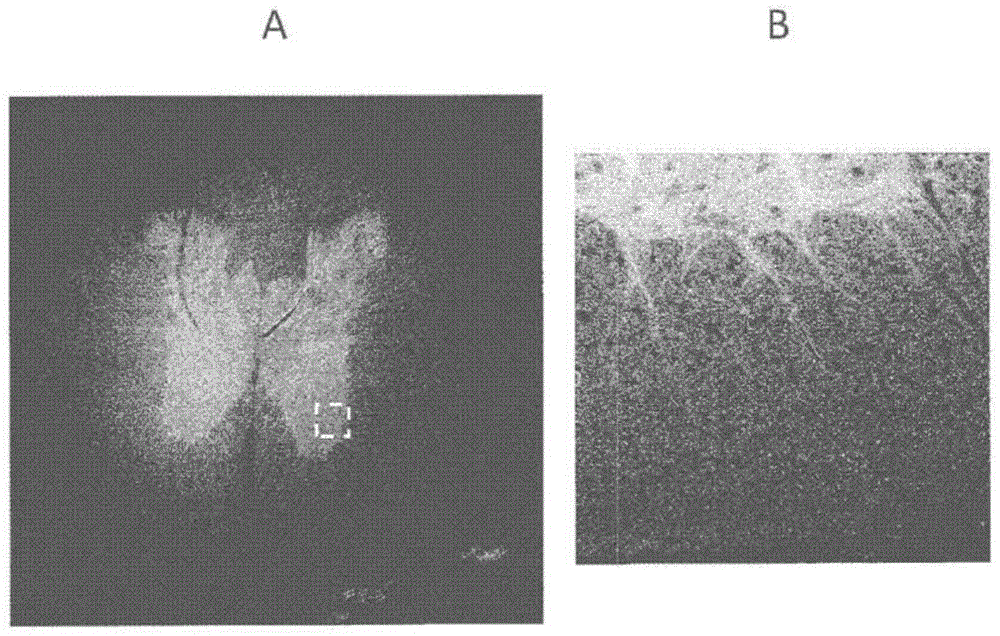Method for rendering tissue transparent, reagent for rendering tissue transparent, and tissue observation method
A transparent and organized technology, applied in biochemical equipment and methods, preparation of test samples, instruments, etc., can solve problems such as laborious and difficult to obtain fluorescent images, and achieve the effect of simple operation
- Summary
- Abstract
- Description
- Claims
- Application Information
AI Technical Summary
Problems solved by technology
Method used
Image
Examples
Embodiment 1
[0112]
[0113] After perfusion and fixation with 4% paraformaldehyde buffer solution, the spinal cord of the rat was excised, and then immersed in the solution for 24 hours for fixation. The fixed spinal cord (diameter 3mm) was successively placed in each pretreatment solution of thiobisdiol:glycerol:sucrose=20:40:40 solution, 50:40:10 solution, and 70:25:5 solution respectively. After 24 hours of immersion, immerse in the final solution of 90:5:5 for 24 hours to perform clearing.
[0114] The result is as figure 1 Shown in B. In addition, A shows the result based on the Scale method described in Non-Patent Document 2. The tissue clearing method (B) according to the present invention can clear the spinal cord more transparently than the Scale method (A). In addition, the Scale method (A) had the problem of doubling the size of the spinal cord, whereas the tissue clearing method (B) according to the present invention did not cause such a problem.
Embodiment 2
[0115]
[0116] Rat brain (tissue thickness 6 mm) was fixed and cleared by the procedure described in Example 1.
[0117] The result is as figure 2 Shown in B. In addition, A shows the result based on the Scale method described in Non-Patent Document 2. The tissue clearing method (B) according to the present invention can clear the brain more transparently than the Scale method (A). In addition, the Scale method (A) had the problem that the brain swelled significantly and easily collapsed when pressed with a finger, whereas the tissue clearing method (B) according to the present invention did not cause swelling or weakening.
Embodiment 3
[0118]
[0119] A transgenic rat expressing the fluorescent protein VENUS in the axons was prepared. The preparation of transgenic rats was carried out by the method described in Non-Patent Document 3 ("Visual properties of transgenic rats harboring the channelrhodopsin-2 gene regulated by the thy-1.2 promoter."PLoS ONE, 2009, Vol.4, No.11, e7679) conduct. The spinal cord fixed and cleared by the procedure described in Example 1 was observed with a confocal microscope (Zeiss, LSA-700).
[0120] Fluorescent images obtained as image 3 As shown in A. B is a magnified image of the area enclosed by the dashed line in A. With the tissue observation method according to the present invention, it is possible to observe nerve axons with high precision. In addition, even under the condition of relatively high concentration of thiobisethanol (90% by volume), the disappearance or attenuation of the fluorescent signal of the fluorescent protein can be suppressed.
PUM
| Property | Measurement | Unit |
|---|---|---|
| thickness | aaaaa | aaaaa |
| refractive index | aaaaa | aaaaa |
| refractive index | aaaaa | aaaaa |
Abstract
Description
Claims
Application Information
 Login to View More
Login to View More - R&D Engineer
- R&D Manager
- IP Professional
- Industry Leading Data Capabilities
- Powerful AI technology
- Patent DNA Extraction
Browse by: Latest US Patents, China's latest patents, Technical Efficacy Thesaurus, Application Domain, Technology Topic, Popular Technical Reports.
© 2024 PatSnap. All rights reserved.Legal|Privacy policy|Modern Slavery Act Transparency Statement|Sitemap|About US| Contact US: help@patsnap.com










